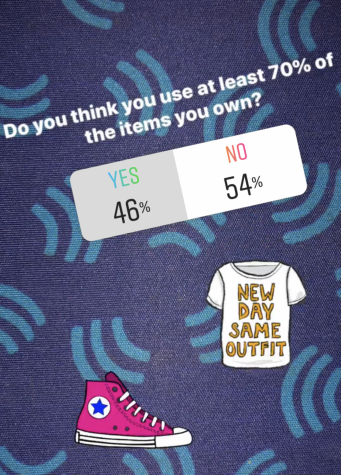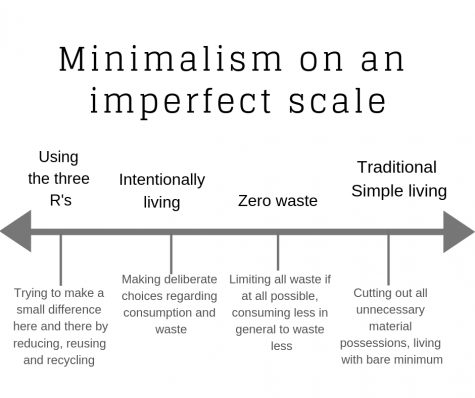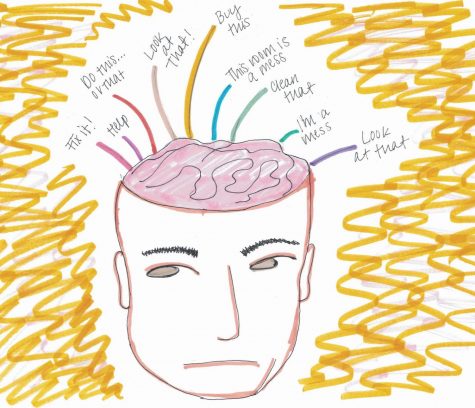The bare minimum: Living intentionally
April 23, 2019
Since the beginning of modern consumption, some people choose to pinch pennies and continue living with as little as possible. Although this subculture currently takes the name of Minimalism, it stems from the long-held idea of “simple living,” practiced by people ranging from Monks, Mahatma Gandhi, enlightenment philosophers, even to some NC students. This idea, Minimalism or “simple living,” encourages people to live with relatively few material items to better use and appreciate what they already own.
“Before social media told everyone that there were all of these minimalists out here, I don’t think minimalism was very well known or that it was a concept that you could participate in unless it was a part of your religion or culture,” Minimalist and Magnet senior Cierra Walsh said.
Typically, an image of a person with all their possessions stuffed into a single backpack or an individual living in a bare-walled house comes to mind at the mention of Minimalism but it takes different forms through the many people who practice it. Minimalists come in variations, some live with nothing, with all the things they find joy in, or with just the necessities. Minimalism teaches people to appreciate their items and how fewer items can breed more happiness.
“In terms of fashion which is what I think will make a difference. I didn’t get rid of a lot of stuff when I started this journey. For me, it’s making use of what you have and not needing to buy new stuff. When you replace old things, be conscious of what you replace them with,” Walsh said.

A poll on Instagram that included 56 NC staff and students responses indicated that over half of them believe they use less than 70 percent of the items they own. With 54 percent of the people utilizing only 20 percent of their items, the trend of overconsumption holds true.
Minimalism breeds a sustainable lifestyle everyone can learn from in the form of intentional living. Lending itself to the idea of owning less, intentionally living means choosing carefully what an individual buys, keeps, and rids him/herself of while not adhering to the strict denotation of minimalism. These individuals care for their personal carbon footprint and waste that comes from consumerism so they carefully chose the items they bring into their lives.
Those who subscribe to a minimal lifestyle hope to reduce their waste as the amount of global waste sores, some even limiting themselves to “zero waste” in hopes of helping preserve the environment which yet remains. These large shifts in human behavior emphasize how individuals become conscious over time of their personal impact.
“In my own personal life, I don’t use plastic anything. If I am getting something to go I have my own container and I have my own silverware in my bag with me and straws which is a big thing. It makes me feel good mentally and it makes me feel like I can breathe. Like I am doing something and contributing,” Walsh said.

Minimalism holds no strict hierarchy or requirements, the smallest minimizing makes a big difference. Even reduction of consumption contributes to a more minimal lifestyle, especially if long-lasting items hold priority. “Now when I buy stuff, I buy things that I will want to have for a long time and I know are just for me instead of buying into fad culture— which I have never been a fan of even as a kid. I recognized that it was a waste of time and energy to invest in something like silly bands. It’s something I never got into because I was like ‘Well, you’re not even going to like silly bands in two months,’ and I was right,” Walsh said.
A large sector of consumption– clothing–finds its audience primarily among younger generations, like those who attend NC. Every year, the amount of waste dramatically increases making the low waste and intentional living idea more impactful. One of the largest waste producers, clothing and textiles, amount to around nine percent (81 pounds of clothing per person) of the waste that ends up in landfills. While nine percent sounds small, when you take into account that around 95 percent of clothing and fabric remains reusable or recyclable after use, the piles of textiles amount to mountains of unnecessary waste.
Even if the tremendous waste does not turn stomachs, the production practices of the clothing industry should. The actual production of clothing exploits workers and the low/unregulated wages of third world countries especially that of children. Typically referred to as “Fast Fashion,” brands like Gap, Forever 21, Zara and H&M purposely set up factories in unsafe locations with the lowest possible wages to keep their prices insanely low. Teenagers like those at NC wear these same brands every day not knowing the true cost of their five dollar t-shirt.

With an abundance of items comes an abundance of stress, especially in modern Western society. “We live in America where it’s all about consumption. It’s all about buy, buy, buy,” Walsh said.
“I have never had a lot of clothes, to me it looks like a lot but to anyone else, it looks like I don’t have anything. Now it just makes me feel better because when I am buying stuff I know I am buying it for me and not a trend. It’s not going to be something I am over in two months because it’s something I really enjoy and if I stop wearing it in a year it’s for my own reasons not because of a fad,” Walsh said.
Sometimes the change to minimalism follows a need for mental stability. A cluttered, busy looking area can contribute to anxiety, overwhelming those already dealing with heavy stress. The attention-grabbing items littering a workspace prove troublesome for people with Attention Deficit Disorder (ADD) who struggle maintaining attentiveness in one place at a time.
The attitude current Americans hold toward consuming encourages constant buying which unsustainably drains the earth; even opting for the simplest form of minimalism could change how long the world remains as we know it. Whether for a small mental stabilizer or a nice ecological boost to the world, minimalism can make a big difference in the world.
